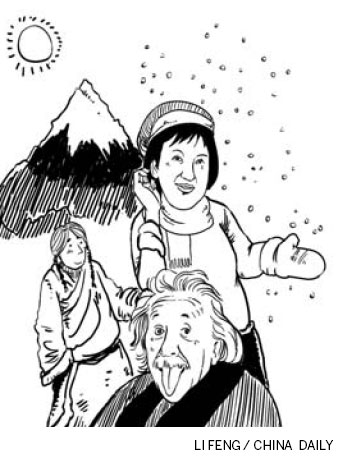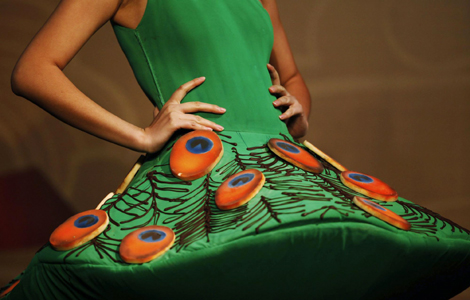Winter chills and warm hearts show a different theory of relativity
Updated: 2011-12-28 09:32
By Lisa Carducci (China Daily)
|
|||||||||

Spring Festival will arrive as early as Jan 23 in 2012. I'm wondering where I will spend it.
In 2010, I spent the Chinese New Year in Chini, a Tibetan village of Diqing prefecture in Yunnan province.
It was in February, and at 3,600 meters above sea level.
When I say that to my friends, their first reaction is, "It must have been very cold!" In fact it was not at all.
I left Beijing at -3 C on Feb 9, and the same day, the temperature was 12 C in Lhasa, capital of the Tibet autonomous region, which is at the same altitude as Chini. Some days later, it was 9 C in Beijing and 23 C in Lhasa. At such altitudes, it seems that we are so close to the sun that we could touch it. If we have to keep on our coats inside the house, we can raise our sleeves outside. It's all relative.
High daytime temperatures don't mean that it never snows. It snowed three nights in a row. The landscape was like a fairytale in the morning, and I took lots of pictures.
However, the family I was visiting had mixed feelings: They were happy because water was desperately needed for the fields but worried because the date of a wedding in the family was close, and the banquet for more than 100 people would be set on the qingke (highland barley) field. Barley is the only cereal that grows at such altitude.
The qingke grass was already 10 to 15 cm high, but they said it was OK to walk and sit on it.
In Montreal, we used to say - jokingly - that there are two seasons: winter and July.
People think that because I was born in Canada, I surely love winter and am used to the cold. Montreal's winters are humid and windy. The best winter days are when it snows, because there is no wind when snowflakes fall, covering the houses, streets and cars under a 1-meter-thick blanket. Snow doesn't mean cold.
This year, I spent the Spring festival with another Tibetan family in Qinghai province's Tongren county.
In Yunnan's Tibetan houses, the fireplace is a square in the soil. Tibetans use wood for cooking and heating, and they sit on the ground on flat cushions or low stools around the fireplace.
In Qinghai, they use an iron stove in the middle of the main room, where the whole family concentrates during the day in winter, while other rooms are closed until the summer. They burn some wood and coal but mostly yak dung, which is odorless and smokeless but burns quite fast.
Every day from 10 am to 3 pm, it was a pleasure to sit outside for sewing, chatting or helping the children with their holiday homework - writing diaries in Chinese and in Tibetan. With more than one piece of clothing, I would sweat. How good was the sun on my arms.
But as soon as the sun disappeared behind the mountain peak, the air became chilly. Inside the house, a coat was needed and hats, scarves and gloves were welcome.
The bedrooms were not heated. I was given the best one, which had a kang (a brick bed that's heated from underneath) that I shared with the family's two girls. When going to bed, it stayed warm under the blankets long enough to fall asleep, although the temperature in the rest of the room was lower than 0 degrees. In the morning, I would find my toothpaste, hand cream and the water left in the basin turned into ice.
Back in Beijing, when people saw my suntan, they thought I had spent two weeks on a beach somewhere in the south.
Snowy mountains and high altitude are relatively closer to the sun.










